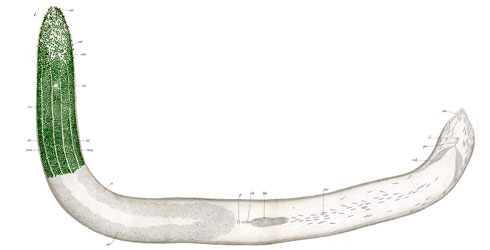Taxonomy
Acoels are flat worms and for a long time, they were considered ‘flatworms’ (members of the phylum Platyhelminthes). However, not all flat worms are flatworms (and not all flatworms are flat!).
They have few or no shared unique characteristics (synapomorphies) with the rest of the species-rich and diverse Platyhelminthes, but it was still a surprise to many morphologists when molecular data demonstrated that acoels do not group with the true flatworms (free-living turbellarians and parasitic flatworms including tapeworms and flukes).
There is now an overwhelming set of independent molecular markers that indicates that acoels are a distinct clade, separate from the flatworms. However, the true position of the Acoela in relation to other multicellular animals (Metazoa) remains controversial, and tantalisingly important. They either:
- are basal bilaterians, on a lineage emerging from the base of the bilaterally symmetrical animals (the Bilateria), or
- emerge within the deuterostomes (animals including echinoderms and the vertebrates)
These pivotal, deeply-branching positions in the animal tree of life have forced scientists to re-evaluate the nature of ancestral and early divergent animal body plans, and to explore further the biology of acoels (approximately 370 species), and their close relatives, the nemertodermatids (approximately15 species).
Symsagittifera roscoffensis was described by Ludwig von Graff who published stunningly illustrated, meticulous studies on the microscopic animals that constitute the meiofauna. He also recognised the pivotal importance of acoel body plans as likely models of the last common ancestor of bilaterians.
The simplicity of flatworms has been used for a long time as a model for reconstructing other animal phyla, but it is important to determine whether they have always been simple, or if they evolved through simplification from more complex animals.
Acoels may hold the most tangible link to distant ancestors. But until their true phylogenetic position can be demonstrated, the role and importance of acoels in understanding the evolution and radiation of the animals is yet to be fully realised.
Evolution
Symsagittifera roscoffensis and other members of the Sagittiferidae are considered to be a relatively derived member of the Acoela. The inter-relationships of the group have been studied using a combination of morphological and molecular tools, and work is in progress to provide a robust evolutionary framework of the Acoela that will provide an insight into the morphology and biology of the stem-group (the ancestral acoel). With its complex musculature and use of endosymbionts, Symsagittifera roscoffensis cannot be used alone to infer the likely nature of the first acoel.
